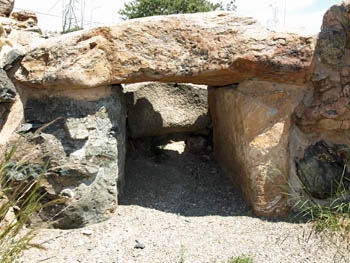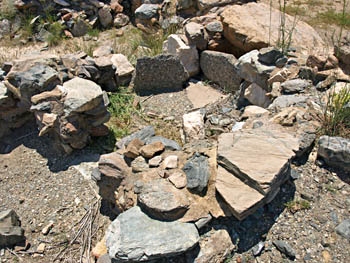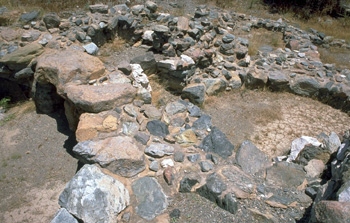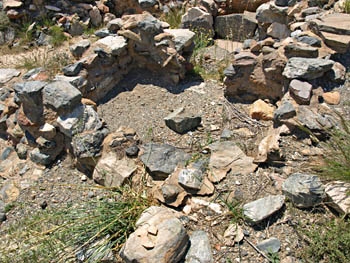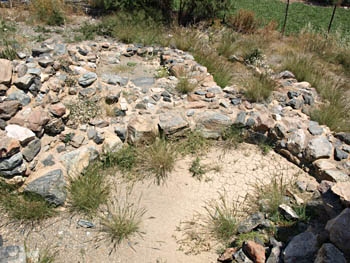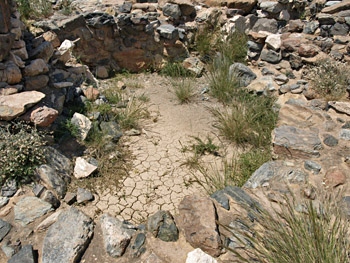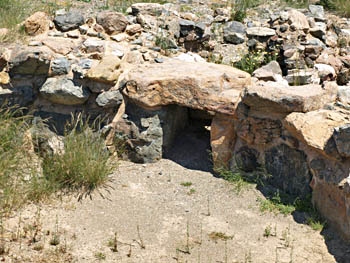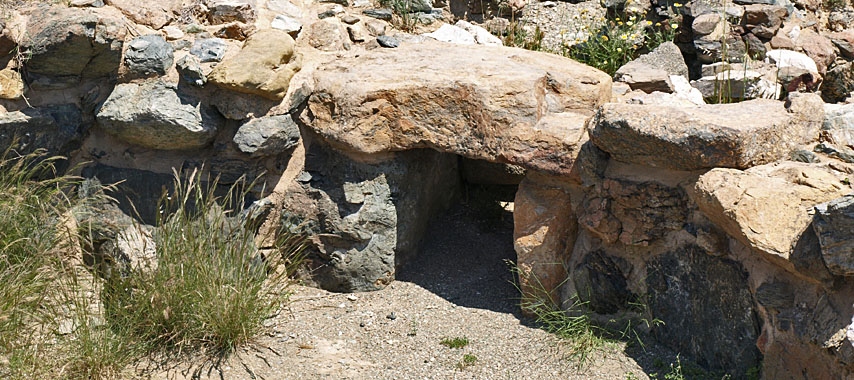
Early Minoan I tombs
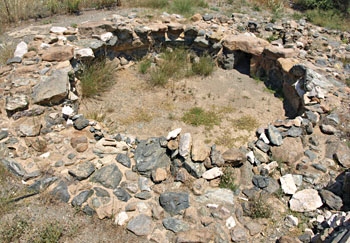
Tomb II at Yerokambos. The trilitho entrance can been seen on the far side of the tomb, and to the left of it partly hidden by grass, a small compartment
Three tombs have been excavated at Yerokambos (also Yerokampos) near the village of Lendas on the south coast of central Crete, south of the Asterousia mountains. Double tomb I and IA (not photographed), located at Papoura, and double tomb II and IIA, located at Yerokambos, are both to the west of Lendas. Tomb III, (not photographed), is located at Zervos to the east of Lenda.
The Yerokambos tholos tombs are located three kilometres to the west of the village of Lendas. The tombs were built in Early Minoan I and pottery found on the upper layer shows that it was still in use throughout Early Minoan II and into Middle Minoan IA. Tomb IIA contained EM II pottery. The settlement that used the Yerokambos tombs has not been found yet.
Tomb II
Tomb II is interesting for a number of reasons. As the excavator, Stylianos Alexious points out "blocks fallen in a regular row like inclined books were found a little above the floor of the tomb. A vaulted or tholos roof struture is thus attested." Apparently the collapse of the tholos happened before the tomb went out of use. The collapsed stones were not removed and the locals continued to bury their dead on a level above the fallen stones, inside the repaired tomb. Two strata were uncovered during the excavations. The lower one was dated to EM I and the upper one to EM II-MM I.
The internal diameter of the tomb is 5.15 metres and the thickness of the wall is 1.9 metres. The remains stand 1.6 metres high at their highest point. There has been much discussion as to whether the tholos tombs of the Mesara had a complete stone vaulted roof or not. During the excavation of Tholos II a large number of stones was discovered. These had fallen from the roof. They represented only a part of what had originally fallen in because many of the stones had been removed by the locals for use in constructing other buildings. So the total quantity of stones that had fallen in suggest that in this case the whole roof was made of stone. But as already mentioned, it was the way that the stones had fallen, in rows, that showed most clearly that the roof had indeed been completely vaulted.
The tomb had been looted at the centre, most probably in ancient times, but the stones from the roof had protected much of the tomb from looting. Against the inside wall of the tomb just to the right of the entrance were the remains of a compartment which had been used for an individual burial. The trilitho entrance, which is 0.6 metre wide, comprises two single upright stones with one single capstone resting on top. The underneath of the capstone, like that of other tombs, had been blackened by fire. This was no doubt caused by the lighted torches which those entering the tomb carried with them.
Because the large number of burials had resulted in the remains of the dead being moved to make room for newer burials it is not possible to know how the bodies were placed inside the tomb. It may be that bodies were placed on top of each other until there was no more room and the skeletons had to be moved. Food offerings had been left for the dead and vases with lids had had their lids removed, in the view of the excavator to allow the dead person to drink or eat what had been left. Olive stones, bones from small animals and birds, snail shells and limpet shells were all recovered from vessels in the tomb. Many vessels were found upside down. While it is not possible to ascertain whether this was done intentionally in this tomb, the presence of large numbers of handleless cups placed upside down in other tombs suggests that this may have been a possibility.
The entrance passage into tomb II was used as an ossuary during MM IA and a large number of human bones were found here. Although the room next to the entrance, room A, was also used as an ossuary in MM I, the stone slab closing the tomb was found in situ when the tomb was excavated. This suggests that the entrance passage (and of course the tomb) were regarded as distinct areas when room A was in use.
Finds in Tomb II
Pottery finds. A huge number of pots were found either intact or in pieces. The minimum number of pots associated with the tomb is 959 and the maximum number of potential vessels actually reaches 2263. The pottery was not made on a potter's wheel and was decorated in a familiar variety of EM I, EM II and MM IA styles. No actual burial with its associated grave goods was identified in the tombs but the vessels can be divided into two main groups.
On the one hand there are vessels for the consumption of food and drink and for pouring the drink. On the other hand there are vessels for storing liquids, including small quantities of liquids like perfumes and for offering and displaying these contents. A very large number of pyxides were found (38% of the vessels whose shape could be identified). These are low, round containers with flat bottoms and lids which were tied so that they were kept in place. The excavators believe that aromatics were the most likely contents of these vessels, with the lids intended to preserve the aroma. While the excavators believe that some of the vessels may have belonged to the deceased and were used by them in life, they are also convinced that the large number of a small group of vessels, in particular the pyxides, suggest that they were placed there specifically for the use of the dead.
Other finds. Apart from pottery a number of other interesting finds were made. From the EM I level came figurines in the Cycladic style, necklaces made from clay beads, as well as cylindrical beads made of steatite, two bronze daggers, a green chlorite seal and vases of Haghios Onouphrios Ware. From the EM II-MM IA level came three bronze daggers and stone vases made from green chlorite schist, a pendant, a ring of grey steatite and 18 seals made from a variety of materials including ivory, chlorite, serpentine and steatite. An Egyptian scarab was also discovered.
Altogether 1138 beads were found in the tomb and the conservators at Heraklion Museum managed to make fourteen separate necklaces from the beads. It was not possible to identify which vessels they had been stored in.
Altogether 124 pieces of obsidian were found in Tomb II. Here, as at other EM tholos tombs in the Mesara and Asterousia, large numbers of obsidian blades were found. At Yerokambos 115 prismatic blades were discovered. These are thought to have had some function in the afterlife for the Minoans. (See the page on Odiyitria EM cemetery for a fuller discussion of obsidian blades).
Tomb IIA
This tomb lies to the south-east of Tomb II and is joined onto the outside of the wall of Tomb II. The internal diameter of this smaller tomb is 3.4 metres and the thickness of the walls is 1 metre. The tomb wall stands 1.15 metres high at its highest point.
The entrance has not been located but the excavator believes it is likely, but not certain, to have been on the north side, in which case, it too would have opened into room A. Alternatively it might have been on the south west where a building now covers that part of the tomb, which consequently remains unexcavated. The tomb was physically joined to the outer rooms A, AN, Δ and M. The tomb also had a vaulted roof.
Finds. Unlike tomb II, the human remains found here had been burnt by a fire which had been lit inside the tomb. The burnt layer was found towards the centre of the tomb where two stones were found, positioned like hearth stones. The fires inside tombs had the function of thoroughly cleaning the tomb and removing by fire of all bodily remains apart from the bones. After being burnt, the bones were covered with sand from the local shore. Among the finds from this lower level were twenty five vessels including a three-footed pyxis and cups in Vasiliki Ware, seven seals (all dated to EM II), some pieces of obsidian and a dagger. From the level above the sand thirty one vessels were found, dating to EM III-MM IA, as well as two foot amulets, five seals (one ivory), 200 beads and an Egyptian scarab. The beads have since been reassembled in six necklaces. Chlorite, serpentine and steatite were the most popular materials for manufacturing beads.
The evidence from the pottery, both its presence and its absence, suggest a tentative dating of the tombs as follows. Tomb II dates to early EM II A, followed by a second phase in late EM IIA when Tomb IIa was built. The lower level in Tomb IIa is considered to have lasted until EM IIB since EM III-MM I pottery is found in the second level, but not in the first.
Rooms A and M
These two rooms were a later addition to the tomb. Room A was probably the last of the outbuildings to be constructed. It contained human bones and may have been built solely to act as an ossuary. However, the presence of animal bones and handleless cups dating from MM IA point either to ceremonial offerings having been made when bones were interred in the room, or possibly to some sort of consecration of the room when it was initially built.
Room A stands immediately to the east of the entrance to the tomb at a slightly higher level than the tomb floor. On its east side there is an entrance to Room M half a metre wide. This was closed off with a slab of stone. The excavators suspect that room M may have been used as an area for placing offerings to the bones in room A.
Room M lies to the east of Room A and was connected to it through the entrance mentioned above. No human remains were found in Room M. Handeless cups and a jug were present and again attest to the likelihood of the room being used for offerings to the dead. The excavator believes that neither room was very high since the entrances were so small.
It seems likely that by early MM IA both tombs were full and went out of use, while rooms AN and Δ as well as the room east of room Δ continued to be used for burials. After Tomb II went out of use its entrance was filled up with bones while the entrance to Tomb IIa was blocked up. At this point rooms A and M were built, with room A covering the entrance to the now defunct Tomb II.
Rooms Δ and AN
These two small rooms lie directly east of Tomb IIa. Room Δ measures 2.60 metres by 1.65 metres and room AN only 1.70 metres by 1.45 metres.
Room AN was used to place offerings using either upright or upturned cups and bowls. There were two benches in the room, one on the west and the other at the north-east corner. However, no pottery was found on these benches. Instead vessels were placed on stands inside the room. A large flat stone has been interpreted as a possible offering table. Alexiou notes the similarity this room has to later Minoan shrines. Given how dark it would have been inside room AN, if rituals did take place there then the the atmosphere inside must have resembled that of a tomb itself.
Altogether 119 vesssels were found in room AN along with sherds representing a further 524 vessels. Given the large number of vessels and the small size of the room, they must have accumulated there over a long period of time. The lowest level of room AN is dated to EM IIB, while the surface level is thought to date from EM III-MM IA. Evidence of burning in room AN could link it to the burning in Tomb IIa while its continued use in EM III-MM IA would link that level to the upper level in Tomb IIa.
Room Δ was larger than room AN, at over four square metres and like room AN could only be entered from above. Because Room Δ contained many human bones and grave goods it may have been built as an overflow chamber when Tomb IIa was full. Only eighteen vessels were found in the room but based on the sherds uncovered, there were likely to have been at least another 77. Apart from the pottery, other finds in room Δ included seventeen beads made from a variety of materials and three stone vases. While attempts to date the construction of Room Δ from pottery finds has proved inconclusive, it seems likely from an architectural point of view that Rooms Δ and AN were built at the same time as one structure. If this is true and we know that room AN dates from EM IIB, then room Δ must date from the same period.
Rooms Δ and AN had certainly been added by the time of the later levels inside Tomb IIa. The excavator believes that the four exterior rooms had flat roofs made from reeds or some other similar material. There was no entrance to rooms Δ and AN and Alexiou believes that there may have been an opening higher up in the wall, through which offerings could have been placed inside. Alternatively part of the roof may have been removed to gain access from above using a ladder.
East of room Δ are traces of another room. Even though almost nothing is left of the walls, when the area was excavated a number of complete vases was uncovered together with a stone vase and a possible stone tool. From the types of pottery found here it seems that this room, too, was used for burials, like room Δ, though this cannot be stated with absolute certainty. An EM IIB construction date is likely.
The site was visited and may even have been used in later periods as finds here have been dated to Late Minoan, Hellenistic and Roman times.
LOCATION: The tombs, which stand just to the right of the coast road West of Lendas, are fenced but can be seen adequately from outside.
SOURCES: The key text on Yerokambos is The Early Minoan Tombs of Lebena, Southern Crete by Stylianos Alexiou and Peter Warren (Studies in Mediterranean Archaeology volume XXX) which was used as a source for much of the information presented here.


